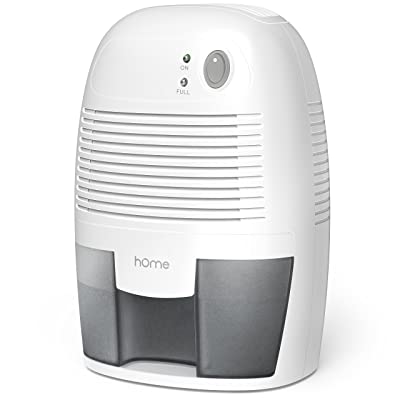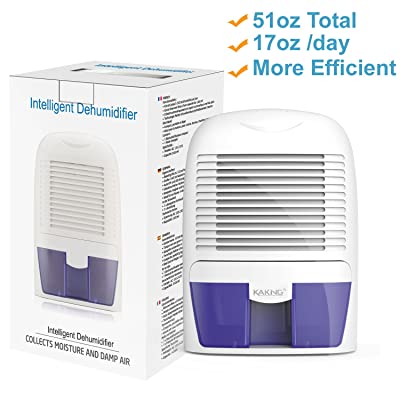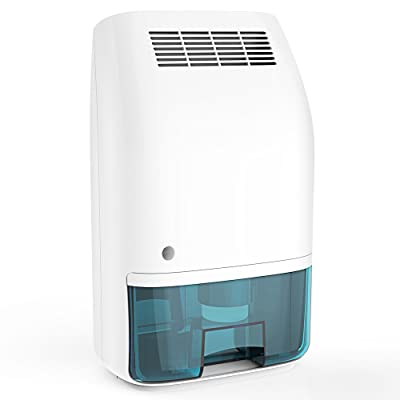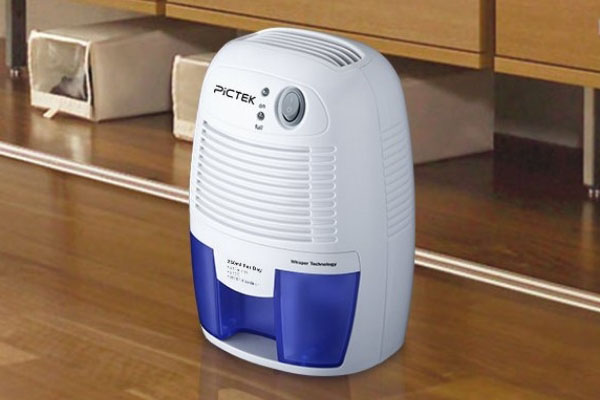When you have a room that is too damp, not only is it uncomfortable, but it can trigger a lot of conditions that are hazardous to your health. Humidity levels over 50% breed dust mites, mold, mildew, and other allergy triggers. When that damp room is also short on space, you will probably start to look for the best small dehumidifier take the humid feeling out of a room and return it to optimal moisture levels.
Here you will find five of the most highly rated small dehumidifiers on the market. Learn how to diagnose whether or not you even need a one and what features to look for in the right dehumidifier for you. Finally, review our tips for maintaining your unit to ensure a long operating life.
Following is an in-depth look at five highly rated small dehumidifiers that work well in bathrooms, bedrooms, RVs, basement storage or other small rooms.
Top 4 Best Small Dehumidifier Reviews
|
MODEL |
Size |
Capacity |
Sound |
Max Room |
Warranty |
|---|---|---|---|---|---|
|
hOmeLabs Small Dehumidifier |
6.5 x 5.3 x 8.5 in, 2.6 lbs |
500 ml |
40dB |
150 sq ft |
Two years |
|
Hysure Dehumidifier, 700ml (24fl.oz) |
13.9 x 6.8 x 4.4 in, 5.9 lbs |
700 ml |
33 dB |
215 sq ft |
Two years |
|
KAIKING Mini Dehumidifier |
8.3 x 6.3 x 11.8 in, 5.05 lbs |
1500 ml |
35 dB |
200 sq ft |
One year |
|
Afloia Electric Home Dehumidifier |
13.9 x 6.5 x 4.2 in, 2.79 lbs |
700 ml |
35 dB |
215 sq ft |
Two years |
Our Top 4 small dehumidifier recommendations:
hOmeLabs Small Dehumidifier for 1200 cu ft (150 sq ft) Bathroom or Closet

This hOme small dehumidifier makes the list because of its truly compact size. If space is enough of an issue that you’re not sure you can fit a dehumidifier at all, look at this one. It works in rooms up to 150 sq feet and measures just 6.5 x 5.3 x 8.5 inches, making it an ideal small dehumidifier for bathroom use. The collection tank can hold 500 ml of water and the machine can pull 250 ml of moisture from the air daily. You’ll need to empty the tank once every two days or so, but an auto shut-off feature and LED indicator light help make this process simple.
Like the Homemaxs, this small dehumidifier uses a thermoelectric peltier module to keep the operation noise low and an energy efficient 25W ETL certified adapter to help prevent overheating. Though the unit is quite small, the attached cord is 6 ft long to give you some flexibility in where it can be placed. It can work in rooms from 15-40 C (59-104F ) and humidity levels from 40-80%.
You get 30 days from purchase to return the product with no questions asked, and a two year warranty on repairs.
SPECS:
- 6.5 x 5.3 x 8.5 inches
- 2.6 pounds
PROS
- Perfect for tight spaces
- Important safety features
- Auto shut-off
CONS
-
- Not be strong enough to replace bathroom exhaust fan
- Should only run for 12 hours at a time
- AC adapter can get warm upon extended use
Hysure Dehumidifier, 700ml (24fl.oz) 1200 Cubic Feet (215 sq ft) Quiet Room Dehumidifier
If you are easily bothered by noise, check out the Hysure dehumidifier. It is the quietest model on our list at just 33 dB. Due to the need for peaceful sleep, the low volume of this unit makes it a good dehumidifier for bedroom use. The tank capacity is 700 ml, and it can pull up to 300 ml of water from the air per day. Featuring one-press control and auto shut-off, this is an easy little device to set and forget, at least for a couple of days until the tank needs to be emptied. It is an energy-saving, environmentally friendly model that won’t waste your electricity and is made from safe ABS plastic.
You get a 30 day money back guarantee with this unit, plus a nice 24 month warranty. To get the most out of your dehumidifier, make sure that the air inlets on the front and outlets on the top are unblocked.
SPECS:
- 13.9 x 6.8 x 4.4 inches
- 5.9 pounds

PROS
- Easy operation
- Good capacity for small dehumidifier
- Extremely quiet operation.
CONS
-
- Takes some time to dry the space
- Can heat up upon extended use
- Only appropriate for rooms up to 215 sq ft.
KAIKING Mini Dehumidifier, Auto Shut Off Portable Electric Dehumidifiers for Damp Air Mold Moisture in Small Closet Wardrobe Kitchen

The Kaiking Mini Dehumidifier is meant for small spaces up to 200 sq feet, but it has a roomy collection tank that can hold 1500 ml of water. Built with low energy consumption in mind, it’s a great little model to turn on and leave for days before you’ll need to empty it. The dehumidifier has large intake holes that allow for collection of up to 500 ml of fluid per day, so you’ll only need to drain the tank every three days on average. Auto shut-off and an LED indicator features help avoid spillover.
Able to work in conditions up to 80% humidity, the bottom of this unit features anti-slip rubber feet. You need not worry about it tipping over if placed on a shelf, counter, or on top of the toilet tank. It works quietly via the manufacturer’s “whisper technology” at about 35 dB.
SPECS:
- 8.3 x 6.3 x 11.8 inches
- 5.05 pounds
PROS
- Anti-slip rubber feet
- Huge capacity for small dehumidifier
- Whisper technology for quiet operation.
CONS
-
- Ambient temp affects how much moisture is collected
- May struggle in rooms without ventilation
- Only appropriate for spaces up to 200 sq ft.
Afloia Electric Home Dehumidifier, Portable Dehumidifier
This Afloia model is a great middle-of-the-road choice that has features to satisfy any small dehumidifier need. It runs quietly at 35 dB, which makes it one of the quietest dehumidifier choices you can make. It can hold up to 700 ml, and manages a space up to 215 sq ft. It pulls up to 300 ml of water from the air per day, and works in environments up to 90% humidity. Designed to be portable at less than 3 pounds, you can easily move the humidifier around from place to place if needed.
The front-oriented water tank is easy to remove and empty, and the auto shut-off feature (plus LED indicator light) protects against spills. The unit is built to be energy conserving. It is not recommended that you run it in temperatures less than 50F (10C), and be sure to keep front air inlets and top air outlets unblocked during operation. To prevent mold growth inside the machine, empty and dry the tank when the unit is not in use.
SPECS:
- 13.9 x 6.5 x 4.2 inches
- 2.79 pounds

PROS
- Energy conserving
- Generous capacity for small dehumidifier
- Works at 35 dB.
CONS
-
- Works best in rooms with windows and doors closed
- Only appropriate for rooms up to 215 sq ft
- Not effective in spaces under 50F.
Features to Consider in a Dehumidifier
Dehumidifiers work by using a fan to move air over refrigerated coils. That cooling pulls moisture from the air, which then drips into a tank. There are a number of features you may want to consider before buying one.
User-Friendly Controls
The more comprehensive and intuitive the controls on your dehumidifier, the better you can customize the settings to your needs. For example, it may be helpful to program a specific humidity level that keeps you comfortable while discouraging the growth of mold.
Auto Restart
This is a useful feature if your humidifier is in a place that you don’t visit very often, like a basement or even a vacation home. Auto restart will turn the dehumidifier back on after a period of power outage like an unexpected blackout or blown fuse. Turning the dehumidifier back on might not be your first thought after regaining power, and it can easily slip your mind.
Pump and Hose Connection
Some humidifiers have pumps that allow them to divert condensed water away from your living space. In a basement, this might be down a floor drain. Otherwise, a hose connection, in conjunction with the pump, can funnel water into a utility sink or even out a window. If you use a window, just be certain that water will flow away from the home and not back into your foundation.
Timer
A timer is helpful to program the dehumidifier to work mainly during the most humid hours of the day or night. It may also save money by running only during off-peak hours when electricity is more affordable.
Frost Sensor
If you are running a dehumidifier in a colder space, it is possible for the coils to become frosted over. Many dehumidifiers have a sensor to turn off the machine if this occurs, because it won’t be able to pull moisture from the air in this state and will only be wasting electricity if it continues to run.
Washable Air Filter
Keeping the air filter clean is an important part of keeping the air in your room clean. It also helps the dehumidifier function optimally. If it has to work too hard to pull air in through the filter, the motor is likely to burn out quickly. Look for a model with a filter that is easy to remove, clean, and replace.
Easy-to-Empty Bucket or Tank
Water is pretty heavy, but with a small dehumidifier, a full tank should be relatively easy to carry. Just look for a collection tank with comfortable handles that can be easily pulled and replaced.
Things to Consider Before Buying
There are a few other things to consider before you buy a small dehumidifier that have to do with your personal space and budget.
Limitations of Small Dehumidifiers
The models we will cover here are small dehumidifiers, and as such, don’t have internal air compressors. That means that their capacity for drawing moisture is less than a larger model that does have a compressor. Where space is an issue small dehumidifiers are absolutely better than nothing, despite their limitations. Plus, with fewer moving parts, you may find that a smaller dehumidifier lasts longer than a larger and more complex model.
Operating Noise
In a smaller space, noise of operation may be a concern. Typical noise levels in dehumidifiers with air compressors range from about 55 to 67 decibels when standing 3 feet away. The small units on our list, however, are not louder than 40 dB. That makes small dehumidifiers without air compressors ideal for use in bedrooms or anywhere noisy operation would be disruptive to comfortable living.
Buy New to Save Money
It might be tempting to buy an older dehumidifier at a garage sale or online in order to save some money. But due to new federal energy standards, older dehumidifiers will not be as energy efficient as the new ones. Operating costs can be steep depending on how often you need to run your dehumidifier, so we recommend buying new to keep that electricity bill down. It’s also important to be able to read the dehumidifier reviews available online for any model you consider buying.
Fix Existing Problems
Even the best dehumidifier can’t do the job if an excessive amount of moisture is getting into the house. It can help to unclog gutters and make sure that the downspouts direct water at least three feet away from the house. Sometimes faulty seals in glass showers or where the toilet meets the floor can cause dripping onto and through the floor, causing water to stain any ceilings below. Leaking pipes or cracked sealant around windows can also be an issue that should be addressed with maintenance.
Understand Capacity
Small dehumidifiers can manage small spaces that are damp but will struggle if the room is overly wet. Dehumidifiers for basement use will likely be a bit bigger, since basements can be quite damp. Small dehumidifiers cost the least overall, but we do recommend that you get the largest small model that will fit in your space so you won’t have to empty it quite so often, and it won’t be forced to run continually to keep up with the humidity.
Time Your Purchase
If you are looking for dehumidifiers on sale, there is basically no bad time to buy. Promotions are often run in June through August because that is when people tend to need dehumidifiers the most. You could find closeout deals in the fall and early winter as the demand drops off and new models go into production. But prices are still very reasonable the rest of the time because many regions stay warm all year long, and homes with a lot of plants also tend to be more humid.
How to Know if You Need a Dehumidifier
Let’s look a little deeper into the options available. Following are in depth dehumidifier reviews.
All rooms contain a variety of particles including dust, mold spores, and chemicals left from construction and cleaning. Some particles like to multiply given the right circumstances – most often warm, moist air. So in these conditions a low level of irritants can spiral and become a real problem. A dehumidifier is a relatively inexpensive way to handle the issue if the cause of the moisture is environmental. If you have leaking pipes, call an expert right away as a dehumidifier won’t be able to stop mold from growing.
Here are the tell-tale signs that your space is too humid.
1 Mold Spots
Mold is relatively easy to see and recognize. Look first in areas that see a lot of humidity normally, such as the ceiling above your shower or the wall behind the toilet. Basements, storage areas, and garages are also typically damp areas where mold can proliferate. Of course, if you live in a very humid region, any room in your home will be prone to mold. It will look like a smattering of dark spots. If the mold spreads very far, you will likely have to replace the walls that are affected.
2 Condensation
Take a look at the glass window panes in your home. Do they have beads of water on them? When a room has too much moisture, a vapor or fog will cling to glass, much like the bathroom mirror after a shower. If your windows look like that all the time, get a dehumidifier running as quickly as possible.
3 Water Run-Off
Sometimes homes suffer from water issues whenever it rains. This can be due to poor construction or the grade of the surrounding landscape. If your basement collects water in the corners, or the walls get damp on a regular basis, a dehumidifier is a vital tool to prevent extensive damage.
You will also need to try and identify the root cause of the dampness, as excess moisture over a long time will cause the walls to crumble and become unsafe, not to mention breed mold.
4 Musty Odors
Your nose can also tell you if there is a mold or mildew problem in your space. A musty smell almost always indicates the presence of something growing. The issue can be environmental or due to windows that aren’t sealed correctly. A dehumidifier can mitigate this problem, but be sure to have any mold removed carefully. Any that is left behind can get a foothold very easily if you forget to empty the dehumidifier for even a day after the tank gets full.
5 Water Damage & Stains
Water stains may show up on the sheetrock covering your walls or ceilings. This is another sure sign that there is too much moisture. Have a professional investigate stains on your home’s walls or ceilings because it can indicate that there is a leaking pipe behind the area. A dehumidifier is a smart first step to prevent any more damage from being done.
6 Rotting Wood
Wood that stays perpetually damp will begin to rot and attract pests like termites. Rotting wood in or around the home can be a sign that there is too much moisture in the area. Run a dehumidifier to pull out the excess water in the air, and replace any affected wood as soon as possible. As long as there isn’t a broken pipe or other source of dripping water, a dehumidifier should help keep the new structures strong for many years. But if rotting wood is not addressed, it will affect the structural integrity of the whole home.
7 New allergies
Finally, if you notice that your allergy symptoms have spiked in intensity, it may be due to excess moisture in the air. As we mentioned earlier, space with a humidity level of 50% can cause airborne allergens like dust mites and spores to multiply excessively. When you breathe them in, allergy symptoms such as runny nose, sore throat, coughing, or sneezing can occur. Running a dehumidifier can really help keep those allergens down and make you more comfortable.
Maintaining a Small Dehumidifier
One of the nice things about a small humidifier is that it has fewer parts than a larger unit. So you won’t have to worry about the air compressor or even an air filter. However, it is still important to give some attention to the external and internal components of a small dehumidifier in order to keep it working reliably.
Keep it Clean
Dust and floating debris tend to collect in the intake and outtake vents, and mold can grow in the moist environment of the collection tank. Regular cleaning of each of these parts can prevent problems that could kill your appliance.
Water Collection Tank
The water collection tank must be emptied frequently. But don’t forget to also clean it every so often with soap and water or a disinfectant wipe. Mold and mildew grow quickly in a moist environment, and when that is inside of a water collection tank, the yucky stuff can be dispersed back into the air, causing allergies or even illness.
Air Intake and Exhaust Grilles
When you get your dehumidifier out for the season, and again when you put it away, it is wise to go over the intake and exhaust grilles using a vacuum with brush attachment. Build-up of dust and debris blocks adequate air flow and can lead to burnout of the motor.
Check Connections
For ideal operation, all of the internal components need to be seated properly. Check on this once or twice a year to make certain that your unit is actually performing as it should be. Simply being powered on doesn’t necessarily mean it is pulling moisture the way it can at its optimal level.
Coils
Every so often, take a look at the coils on the back of the unit. If they freeze at any point, the machine will sound like it is working but not collect water. Repeated freezing and thawing of the coils will shorten their life a lot, so pay attention to the temperature guidelines in your unit’s manual. Most dehumidifiers aren’t made to work in very cold conditions.
Coils that have come loose will struggle to stay uniformly cool, so if you notice any hotspots as you run your fingers along the coils, the dehumidifier won’t be pulling as much moisture as it otherwise could. Sometimes loose coils can be firmly reseated by hand; if you’re not sure about it, take the unit for repair by a professional.
Electric Cords
Like any device that uses electricity, it is very dangerous to use a power cord that is frayed. If your dehumidifier has a plug-in at both ends (i.e., can be removed from the dehumidifying unit), it is relatively easy to replace a frayed cord with an aftermarket accessory without having to get a whole new dehumidifier. If not, however, when the cord becomes dangerous, it’s time to get a new machine. Burning down the house is one way to eliminate excess humidity, but we don’t recommend it!
Now that you know what you can and can’t expect from the best small dehumidifier, you’re ready to buy one that fits perfectly in the space you have. All of the models on our list are a real blessing to have in a small space, especially as they can sit nicely on top of surfaces and won’t take up valuable floor space or get kicked over by accident. There’s no need to bend down to empty the collection tank when the units sits up higher, either. We hope that with a new dehumidifier, you are able to enjoy a more comfortable room that is healthier, too.




